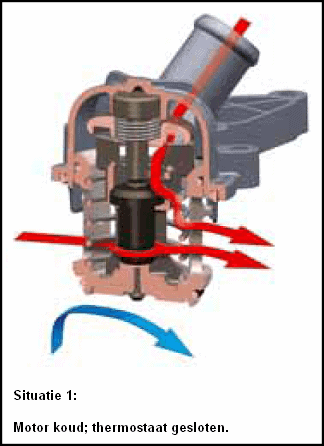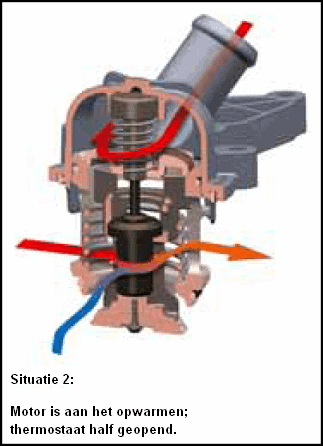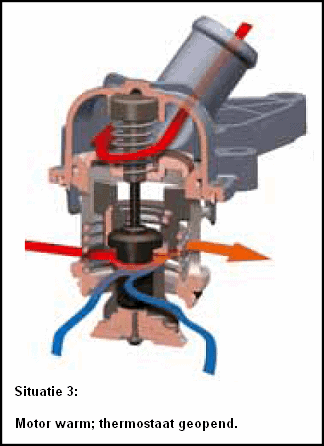Subject:
- Thermostat
Thermostat:
The thermostat is a mechanical part that regulates the coolant circulation and thus the temperature. The technique is old; namely by expanding a certain amount of wax. Due to the expansion at a higher temperature, a pin is pressed against the spring pressure. There are also thermostats with a bimetal (flexes when heated) and electronically controlled thermostats.
When the coolant flows through the radiator, it is colder at the exit than when it entered the radiator. This is because the wind or the cooling air fan has blown air through the radiator fins. If the engine has just started, it should be at operating temperature (90 degrees) as soon as possible. With a cold engine, among other things, the fuel consumption and mechanical wear are greatest. The faster 90 degrees is reached, the better. Until the engine is at operating temperature, there should be no or minimal flow of cooled coolant from the engine to the radiator. The access to the radiator must therefore be closed. The thermostat takes care of that.
Situation 1. The engine has just started and the coolant temperature is the same as the outside air temperature. There is no circulation through the radiator (the blue arrow). The radiator is disconnected from the engine cooling system at this time. The coolant is pumped through the entire engine by the water pump, which heats up very quickly.

Situation 2. The engine has been running for a while and the coolant temperature is rising. The wax in the thermostat expands slightly, causing it to open a small part. A small amount of coolant can now flow from the engine to the radiator. This already happens at a coolant temperature of around 85 degrees Celsius.

Situation 3. The engine is at operating temperature, often 90 degrees Celsius. The thermostat is now fully open. The coolant is now pumped from the engine through the radiator. The warm coolant from the engine is cooled in the radiator. The coolant will flow back to the engine from the radiator.

While driving, you will always switch between situation 2 and 3. More engine load or less wind will cause a higher coolant temperature. A higher engine load occurs when accelerating or driving up a hill and the situation with little wind can arise when driving in a traffic jam or idling.
When driving on the highway, situation 2 will apply; the maximum amount of wind through the radiator cools the coolant well. Because a lot of cold liquid enters the engine, there is a chance that it cools down too quickly. The thermostat is then closed slightly again.
Situation 3 will apply to city traffic with a lot of standing still; because there is little wind flowing through the radiator, the liquid is cooled less. Therefore, a greater amount of coolant flow is required to avoid overheating. The radiator fan will also try to cool this coolant as much as possible. In changing situations, the thermostat will therefore always regulate the coolant circulation.
With a defective thermostat, it often remains in situation 2. This will then remain open. This can often be clearly seen from the temperature gauge on the dashboard; when the vehicle is stationary (with the engine running), the temperature rises neatly to 90 degrees and when driving at a higher speed, the temperature drops again to, for example, 60 degrees or lower. When driving, the thermostat should close something again, which does not happen (see the explanation above). The thermostat will therefore have to be replaced.
